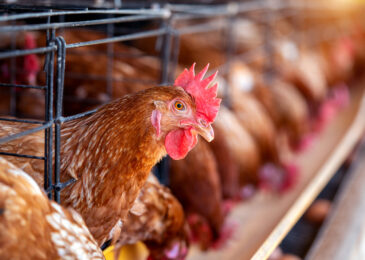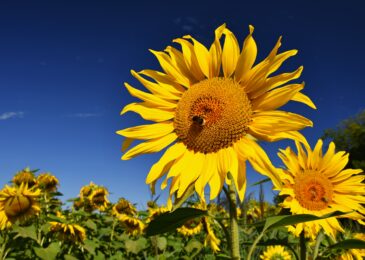Contents
- 1 7 Steps to Successfully Cultivate Miniature Corn Varieties in Indoor Containers
- 2 Selecting the Right Container
- 3 Selecting the Appropriate Corn Variety
- 4 Preparing a High-Quality Potting Mix for Indoor Corn
- 5 Planting Corn Seeds with Precision
- 6 Ensuring Optimal Light Conditions for Indoor Corn Plants
- 7 Watering and Moisture Management for Indoor Corn Plants
- 8 Proper Fertilization for Healthy Indoor Corn Plants
- 9 Supporting the Upright Growth of Your Indoor Corn Plants
- 10 Indoor Corn Pollination: Nurturing Successful Reproduction
- 11 Harvesting Indoor Corn: The Art of Timing and Precision
- 12 Conclusion
7 Steps to Successfully Cultivate Miniature Corn Varieties in Indoor Containers
Introduction
Growing corn indoors in containers may sound like a challenging endeavor, but with the right preparation and care, it can be a rewarding experience that allows you to enjoy fresh corn throughout the year. Whether you’re a gardening enthusiast or have limited outdoor space, this guide will walk you through the steps to successfully cultivate corn indoors.
Selecting the Right Container
The choice of container for your indoor corn cultivation plays a pivotal role in the overall success of your corn crop. To understand the significance of this decision more deeply, let’s delve into the key factors that make container selection a critical consideration.
- Root Space: Corn plants are known for their extensive root systems, which are vital for absorbing nutrients and anchoring the plants. When grown indoors, these roots need sufficient space to expand and thrive. Therefore, selecting a spacious container is paramount to accommodate the corn’s root development without constraints.
- Structural Support: Corn plants can grow quite tall and become top-heavy as they mature. A substantial container with a sturdy structure is essential to prevent tipping or collapsing under the weight of the corn plants. This structural support ensures the stability and longevity of your indoor corn crop.
- Size Matters: Containers with a capacity of 5 gallons or larger are considered ideal for growing corn indoors. The larger volume of soil provides more room for the roots to spread out and access nutrients, which is essential for healthy growth and robust yields.
- Drainage Considerations: Adequate drainage is a non-negotiable aspect of container selection. Without proper drainage holes, excess water can accumulate in the container, leading to waterlogged soil and root rot. Drainage holes allow excess water to escape, maintaining the right moisture levels for your corn plants.
In summary, choosing the right container for your indoor corn cultivation is more than just a practical consideration; it’s a critical factor that directly impacts the health and growth of your corn crop. By opting for a spacious, structurally sound container with proper drainage, you provide your corn plants with the ideal environment to thrive and produce a bountiful harvest.
Selecting the Appropriate Corn Variety
When embarking on the journey of indoor corn cultivation, the choice of corn variety holds profound significance. To gain a deeper understanding of this crucial decision, let’s explore the nuances of selecting the right corn variety for indoor container gardening.
- Growth Characteristics: Corn varieties can differ significantly in terms of growth habits. Traditional field corn, for instance, can reach towering heights, making it impractical for indoor cultivation. In contrast, dwarf or miniature corn varieties have been specifically bred to be more compact and manageable in size. This makes them the preferred choice for indoor containers, where vertical space is limited.
- Container Suitability: Dwarf and miniature corn varieties are inherently more suited to container gardening due to their compact stature. Their reduced height not only accommodates indoor spaces but also simplifies the logistics of providing adequate support within the container. This ensures that your indoor corn crop can flourish without the challenges posed by taller corn varieties.
- Space Optimization: Growing corn indoors often involves working with confined spaces, such as balconies or windowsills. Opting for compact corn varieties allows you to maximize space efficiency while still enjoying the pleasures of homegrown corn. This is particularly beneficial for individuals with limited gardening areas.
- Variety Recommendations: To help you get started, consider varieties like “Patio Pride” or “Miniature Popcorn.” These have been specifically developed for container gardening and offer excellent yield potential, flavor, and adaptability to indoor conditions. Exploring such specialized varieties can enhance your indoor corn-growing experience.
In conclusion, selecting the right corn variety for your indoor container garden is more than a matter of preference; it’s a strategic decision that directly influences your success and enjoyment as a corn cultivator. By opting for dwarf or miniature corn varieties, you not only address the spatial limitations of indoor gardening but also unlock the full potential of your indoor corn crop, ensuring a rewarding and bountiful harvest.
Preparing a High-Quality Potting Mix for Indoor Corn
The composition of your potting mix is a foundational element in the success of your indoor corn cultivation. Let’s dive deeper into the intricacies of preparing a premium-quality potting mix that optimally supports the growth of your corn plants.
- Well-Draining Soil: Corn plants have a strong preference for well-draining soil. This characteristic ensures that excess water doesn’t accumulate around the roots, which can lead to root rot and other issues. A potting mix with excellent drainage is, therefore, crucial for the overall health of your corn crop.
- Balanced Components: To create an ideal potting mix for corn, consider combining three key components in equal parts:
- Garden Soil: High-quality garden soil provides a foundation rich in essential nutrients, promoting healthy growth and robust yields.
- Compost: Compost is a nutrient powerhouse that enhances the fertility of the soil, enriching it with organic matter, beneficial microorganisms, and a host of vital nutrients.
- Perlite or Vermiculite: These components serve a dual purpose. They enhance drainage by improving soil aeration and water retention. Additionally, they create a lighter, fluffier texture in the potting mix, facilitating root growth and nutrient uptake.
- Proper Container Filling: When filling your chosen container with this meticulously prepared potting mix, leave approximately an inch of space from the top. This space allows for easier watering without the risk of soil spillage and provides ample room for your corn plants’ root systems to expand and flourish.
By understanding the importance of each element in your potting mix, you can create an environment in which your indoor corn crop can thrive. The well-draining, nutrient-rich, and aerated soil will promote healthy root development, vigorous growth, and ultimately, a rewarding corn harvest.
Planting Corn Seeds with Precision
The process of planting corn seeds in your indoor container garden is a critical step that can significantly impact the development and yield of your corn crop. To gain a deeper understanding of this essential stage, let’s explore the intricacies of planting corn seeds with precision and care.
- Planting Depth: Corn seeds should be sown at a depth of approximately 1 inch within the prepared potting mix. This depth ensures that the seeds are adequately covered, promoting germination and protecting them from drying out. Planting too shallow may expose the seeds to adverse environmental conditions, while planting too deep can hinder their emergence.
- Spacing Considerations: Proper spacing between corn seeds is crucial for individual plant health and optimal utilization of the container space. Allow a generous spacing of 9 to 12 inches between each seed. This spacing provides ample room for each corn plant to develop a robust root system, access nutrients, and receive adequate light. Adequate spacing also minimizes competition for resources among neighboring plants, ensuring healthier growth.
- Container Size: The size of your container can influence the number of corn plants you can successfully grow. Smaller containers may accommodate one or two corn plants, while larger containers can support more. Ensure that you consider the container’s size and the recommended spacing when determining the number of corn seeds to plant. Overcrowding can lead to stunted growth and lower yields.
- Planting Technique: When placing the seeds in the soil, handle them with care to prevent damage. Create small, evenly spaced holes in the potting mix, plant a single seed in each hole, and then gently cover them with soil. Press the soil down lightly to ensure good seed-to-soil contact, which aids in germination.
By adhering to these planting guidelines, you provide your corn seeds with the best possible start in your indoor container garden. This precision ensures that each seed has the space, nutrients, and conditions required to develop into healthy corn plants, setting the stage for a successful indoor corn cultivation experience.
Ensuring Optimal Light Conditions for Indoor Corn Plants
The light requirements for indoor corn cultivation are a critical aspect that can profoundly influence the health, growth, and productivity of your corn plants. To gain a deeper understanding of this essential factor, let’s explore the intricacies of providing adequate light for your indoor corn crop.
- Sunlight Necessity: Corn plants are inherently sun-loving and thrive when exposed to ample natural light. To promote successful growth, it’s essential to place your container in a location where it can receive a minimum of 6-8 hours of direct sunlight daily. This ensures that your corn plants can harness the energy needed for photosynthesis, essential for producing energy and building plant structure.
- Understanding Light Levels: Corn plants require a substantial amount of light to develop optimally. When grown indoors, they may not receive the same intensity of sunlight as they would in an outdoor setting. Therefore, it’s crucial to gauge the light levels within your indoor space. Consider using a light meter to measure the intensity of light your corn plants receive. Aim for a reading that aligns with their sunlight requirements.
- Supplementing with Grow Lights: In environments where natural light is limited or inconsistent, supplementing with grow lights becomes a valuable strategy. Grow lights designed for plants can provide the necessary spectrum of light, including both blue and red wavelengths, which are crucial for photosynthesis and flowering. Position the grow lights above your corn plants at the appropriate distance to ensure they receive uniform and sufficient illumination.
- Light Duration: Corn plants also require a consistent duration of light to maintain their growth cycles. Mimic the day-length or photoperiod requirements of corn by providing 16 hours of light and 8 hours of darkness during the vegetative phase. As the plants enter the reproductive phase, gradually reduce the light duration to 12 hours of light and 12 hours of darkness to stimulate the development of ears.
In summary, the provision of adequate light for your indoor corn crop is a fundamental aspect of successful cultivation. By understanding the sunlight needs, supplementing with grow lights when necessary, and managing the light duration in alignment with the growth stages, you create an environment where your corn plants can thrive, ultimately resulting in a healthy and bountiful harvest, even within indoor settings.
Watering and Moisture Management for Indoor Corn Plants
Maintaining appropriate moisture levels is a critical aspect of nurturing healthy and productive indoor corn plants. To gain a deeper understanding of this essential care component, let’s explore the intricacies of watering and moisture management for your indoor corn crop.
- Consistent Moisture: Corn plants have a strong demand for consistent moisture, particularly during their active growth phases. To meet this need, it’s essential to ensure that the potting mix remains evenly moist. Regularly check the soil’s moisture level by inserting your finger about an inch deep. Water when the top inch of soil feels slightly dry to the touch.
- Avoid Waterlogged Soil: While consistent moisture is crucial, it’s equally important to prevent waterlogged soil. Overwatering can lead to root suffocation, rot, and other moisture-related issues. To avoid waterlogged conditions, choose containers with adequate drainage holes, allowing excess water to escape freely from the container.
- Base Watering: When watering your corn plants, target the base of the plants rather than wetting the leaves. Wet foliage can create an environment conducive to fungal growth and disease. Directing water to the base ensures that the roots receive the moisture they need while minimizing the risk of fungal issues.
- Saucer Usage: Placing a saucer or tray under the container serves multiple purposes. It catches excess water that drains from the container, preventing it from pooling around the roots and causing root rot. Additionally, a saucer can help maintain a more stable moisture environment by allowing the plant to absorb excess moisture when needed and reducing the risk of soil drying out too rapidly.
- Avoid Watering from Above: Watering from above can disturb the soil and potentially dislodge young corn plants. To prevent this, use a watering can or a soaker hose to apply water directly to the base of the plants. This targeted approach ensures that the water reaches the roots without disturbing the surrounding soil.
By mastering the art of watering and moisture management for your indoor corn crop, you create an environment where your corn plants can thrive. Striking the right balance between consistent moisture and avoiding waterlogged conditions is key to supporting robust growth and preventing common issues like root rot and fungal diseases.
Proper Fertilization for Healthy Indoor Corn Plants
Fertilizing your indoor corn crop is a vital practice to ensure your plants receive the essential nutrients needed for vigorous growth and a bountiful harvest. To delve deeper into this crucial aspect of corn cultivation, let’s explore the intricacies of fertilization and its role in nurturing your corn plants.
- Heavy Feeding Nature: Corn plants are renowned for their heavy feeding nature. They demand a substantial amount of nutrients to support their rapid growth and the development of large ears of corn. Understanding this characteristic is essential to provide the right amount of nourishment for your indoor corn crop.
- Balanced, Slow-Release Fertilizer: To meet the nutrient requirements of your corn plants, begin by using a balanced, slow-release fertilizer. Slow-release fertilizers provide a steady supply of nutrients over an extended period, which aligns well with the prolonged growing season of corn. Look for a fertilizer with a balanced N-P-K (Nitrogen-Phosphorus-Potassium) ratio to ensure a well-rounded nutrient supply.
- Timing Matters: Commence fertilization when your corn plants reach a height of approximately 6 inches. This stage marks the onset of their active growth phase, and providing nutrients at this point supports robust development. Continue to fertilize every 4-6 weeks throughout the growing season to sustain consistent nutrient availability.
- Proper Application: Following the fertilizer package instructions for proper application is crucial. Measure the fertilizer accurately and distribute it evenly around the base of each plant. Avoid direct contact between the fertilizer and the plant’s stems or leaves, as this can cause burn or damage.
- Nutrient Monitoring: Regularly monitor your corn plants for signs of nutrient deficiency, such as yellowing leaves or stunted growth. Adjust your fertilization schedule or nutrient levels if needed to address any deficiencies promptly.
- Soil Testing: Conducting periodic soil tests can provide valuable insights into your corn plants’ nutrient requirements. Soil tests can help you fine-tune your fertilizer application based on your specific soil composition and the nutrient needs of your plants.
recognizing corn’s heavy feeding nature and implementing a strategic fertilization regimen is paramount to achieving healthy and productive indoor corn plants. By using slow-release, balanced fertilizers, timing applications effectively, and monitoring nutrient levels, you can provide your corn crop with the essential nourishment it requires for vigorous growth and the successful production of homegrown corn.
Supporting the Upright Growth of Your Indoor Corn Plants
As your indoor corn plants progress through their growth stages, the need for structural support becomes increasingly important to prevent them from leaning or toppling over. To explore this crucial aspect of corn cultivation in greater depth, let’s delve into the nuances of providing support to ensure your corn plants grow upright and strong.
- Growth Dynamics: Corn plants have a natural inclination to reach for the sun as they grow. However, indoor conditions may not provide the same stability as outdoor soil. As the plants mature and their foliage expands, they can become top-heavy, making them susceptible to bending or falling over.
- Choosing Support Methods: Two common methods for supporting indoor corn plants are stakes and trellis systems.
- Stakes: Stakes are vertical supports that are individually placed near each corn plant. They provide localized support by preventing individual plants from leaning. Secure the corn plants to the stakes using soft ties or twine, being careful not to damage the plant’s stems.
- Trellis System: A trellis system is a more comprehensive approach and is particularly beneficial when you have multiple corn plants in a single container or limited space. It consists of a framework of horizontal and vertical supports that create a lattice for the corn plants to grow through. Trellises help distribute the weight of the plants and promote upright growth.
- Placement and Installation: Install stakes or trellis systems early in the corn plants’ growth stages, ideally when they are still relatively small. This prevents the risk of damaging the roots or disrupting the plants’ growth later on. Ensure that the supports are firmly anchored in the potting mix to provide stable and reliable support.
- Adjustment and Monitoring: As your corn plants continue to grow, periodically check the stability of the supports. Adjust the ties or connections as needed to accommodate the increasing height and girth of the plants. Regular monitoring ensures that your corn plants remain upright and well-supported throughout their growth cycle.
- Harvest Considerations: Keep in mind that a sturdy support system not only aids in growth but also simplifies the process of harvesting corn. When the time comes to harvest, you can easily access the ears without risking damage to the plants.
By implementing effective support measures, you not only encourage your indoor corn plants to grow straight and tall but also enhance their overall health and productivity. These support systems are a key component in ensuring a successful indoor corn cultivation experience, ultimately leading to a satisfying corn harvest.
Indoor Corn Pollination: Nurturing Successful Reproduction
Pollination is a pivotal aspect of indoor corn cultivation, as corn plants rely on wind to transfer pollen from male tassels to female silk for successful fertilization. To gain a deeper understanding of this critical stage and how to facilitate it effectively in an indoor environment, let’s explore the intricacies of indoor corn pollination.
- Wind Pollination Challenge: Corn’s reliance on wind for pollination can be challenging indoors, where air circulation is often limited compared to outdoor conditions. This limitation can hinder the natural dispersal of pollen from the male flowers (tassels) to the female flowers (silks) on the lower part of the plant.
- Manual Pollination Technique: To ensure proper pollination and successful fertilization, you can adopt a manual pollination technique. When the corn plants begin producing tassels (male flowers) at the top, you can gently shake the plants to encourage the dispersal of pollen. This mimics the action of the wind and facilitates the transfer of pollen to the silks (female flowers) lower down the plant.
- Timing Is Key: Timing is crucial when implementing manual pollination. Wait until the tassels are fully developed and shedding pollen, which typically occurs a few days after they first emerge. You can check for pollen by gently tapping a tassel over a piece of paper; if pollen falls, it’s ready for pollination.
- Silk Care: When applying pollen to the silks, it’s essential to handle them delicately. The silks are the receptive parts of the female flowers, and they extend from the developing ears of corn. Carefully lift the silk covering from an ear and expose the kernels beneath. Apply the pollen by gently brushing the tassel over the silks, allowing the pollen to fall onto the exposed kernels.
- Repeat as Necessary: Since indoor conditions may not provide as effective pollen distribution as outdoor wind, consider repeating the manual pollination process several times as new ears of corn develop. This ensures that each ear receives ample pollen for successful fertilization.
By embracing the role of a surrogate wind and meticulously facilitating the pollination process, you can overcome the challenge of wind pollination in an indoor setting. This hands-on approach guarantees that each ear of corn is adequately pollinated, ultimately leading to the development of plump and juicy kernels ready for harvest.
Harvesting Indoor Corn: The Art of Timing and Precision
Harvesting indoor corn is a rewarding culmination of your efforts as a corn cultivator. Understanding the intricacies of when and how to harvest indoor corn will ensure that you enjoy the fruits of your labor at their peak of flavor and quality. Let’s explore the nuanced aspects of indoor corn harvesting in greater depth.
- Accelerated Maturation: Indoor corn often matures more rapidly than its outdoor counterparts due to the controlled environment and optimized growing conditions. This accelerated growth is a result of consistent light, temperature, and moisture levels.
- Visual Cues: To determine the ideal harvest time, pay close attention to the appearance of the corn kernels. When they become plump and milky, it’s a clear indication that the corn is ready for harvest. At this stage, the kernels have reached their maximum size and sugar content, ensuring the sweetest and juiciest corn.
- Silk Timing: Harvest timing often correlates with the appearance of silks, which typically emerge about 20-25 days before the ideal harvest window. The presence of silks is a visual cue that the pollination process has taken place, and the ears are developing.
- Hand Harvesting: To harvest your indoor corn, gently twist the ears off the stalk when they are ready to be enjoyed. Grasp the ear firmly and give it a slight twist while pulling downward. The ear should detach easily from the stalk, indicating that it’s fully ripe.
- Harvest All at Once: It’s often best to harvest all your corn at once when the majority of the ears are ready. However, if some ears are not yet mature, you can leave them on the plant for a few more days before harvesting. This staggered approach ensures that you don’t miss the prime harvest window for any ears.
- Enjoy Fresh: The beauty of indoor corn cultivation is the opportunity to enjoy it at its freshest. Once harvested, corn begins to lose its sweetness rapidly. Therefore, consume your freshly picked corn as soon as possible to savor its peak flavor and quality.
By recognizing the visual cues of readiness, understanding the accelerated maturation of indoor corn, and adopting the gentle twisting technique for harvesting, you ensure that each ear you pick is bursting with sweet, milky kernels. Harvesting indoor corn is a satisfying conclusion to your indoor gardening journey, delivering the delightful taste of homegrown corn to your table.
Conclusion
Growing corn in containers indoors is a unique gardening adventure that can be accomplished with the right knowledge and care. By selecting the right container, providing proper care, and ensuring adequate sunlight and pollination, you can enjoy the sweet taste of homegrown corn no matter where you live. Experiment with different corn varieties to find the one that suits your indoor gardening conditions best, and enjoy the satisfaction of harvesting your very own corn crop.





